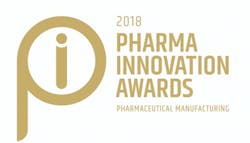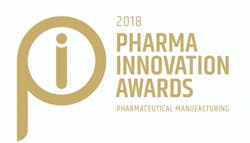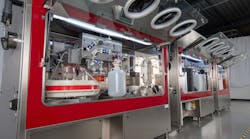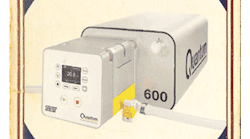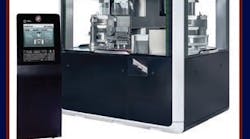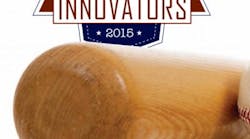When it comes to famous “eureka” tales of innovation, Isaac Newton taking an apple to the head and suddenly coming up with the theory of gravity is perhaps the most famous. It’s inspiring to think that at any moment, a brilliant idea can literally hit you on the head. But while it’s tempting to condense historical stories of innovation into quick anecdotes, more often, innovation is the result of an elaborate and collaborative process.
Here at Pharmaceutical Manufacturing, we understand the time and investment pharmaceutical equipment suppliers put into their products. And we feel that this type of innovation should be recognized. As such, this month’s cover story highlights and applauds those who have distinguished themselves as leaders in pharmaceutical equipment innovation.
With that said, we are proud to introduce this year’s Pharma Innovation Award winners: recently launched or updated technologies and systems that, based on their relative practical and technical merits, were selected by Pharmaceutical Manufacturing’s editors and reviewers.
BIOPROCESSING
As the market demand for biopharmaceuticals grows, drug manufacturers are looking for new strategies to meet global needs. Modern therapies are proving more difficult to sterilize and handle and require faster speed to market — further emphasizing the need to take advantage of new technologies and explore new ways of addressing process control and efficiency.
Our bioprocessing category encompasses the broad range of equipment and technologies needed to maintain a sterile, streamlined reaction from the lab to the plant floor. This year’s winners include everything from a vial filler for clinical trials to a single-use component recycling program.
[javascriptSnippet]
Starting on the clinical side, our first winner — from a company making its second consecutive appearance on our innovator list — is the Vanrx Microcell Vial Filler. The Microcell is a fully integrated gloveless robotic isolator for pharmaceutical vial filling that can be used to make clinical trial supplies and develop new products — including autologous cell therapies and personalized medicines.
Traditional manual filling and small-volume filling machines that combine with biosafety cabinets, RABS or isolators are often costly, difficult and time-consuming to integrate. This Microcell can be used as a replacement for these machines.
Small but mighty (under 6’ wide and just over 7’ high), the compact unit is extremely agile, giving operators the ability to fill up to four products in a single day. As a gloveless isolator, the unit eliminates operator error and shields them from contact with potentially dangerous drug products. By providing cost-effective, flexible filling capacity, the isolator has the potential to help drugmakers bring drug products to market faster.
Speaking of small but mighty, our next winner is a six-inch manufacturing game-changer. Micropore Technologies’ AXF-1 is an innovative new design of in-line mixer, providing the ability to produce a high-quality emulsion, with a tightly controlled particle size distribution, at high throughputs. Capable of processing up to 1,400 tonnes of product per year, the device uses a process called membrane emulsification, where one substance is passed continuously through a tube laser-drilled with microscopic holes while a second substance passes around the tube shearing off droplets as they form through the tiny pores. These droplets can be turned into microcapsules and controlled release systems of precision-controlled size.
Easy to assemble, operate, dissemble and clean, the stand-alone membrane emulsification device can produce near mono-dispersed droplets. In pharma, the economic benefits of producing droplets that are all the same size in a low energy process include a tremendous reduction in unwanted product destruction and energy usage. While membrane emulsification has existed for years on a laboratory scale, the AXF-1 scales this process up to be usable for mass production — which is truly unique.
Next up is the OpenBIO Benchtop Bioreactor from Panacea Technologies — an impressive addition to modern laboratory systems.
Designed to be the “centerpiece” of your laboratory operations, the fermenter platform can be controlled from anywhere with a tablet, phone or computer — a truly mobile experience for staff. Remote notification and an alarm system keeps batches and experiments running by informing staff of critical events, even when they are off-site.
Scalability is also easy — whether your application requires a single bioreactor or several hundred, the configuration is straightforward. Hybrid-cloud based architecture makes adding bioreactors as easy as plugging in a network cable.
The platform is designed for immediate deployment in most lab settings. In order to avoid downtime that could occur when parts need to be replaced, the platform is built with standard hardware — enabling greater lab productivity. As an added bonus, Panacea is a member of the Control System Integrators Association (CSIA) — a not-for-profit, global trade association — which adds an additional layer of assurance for plant managers looking for reliable partners in industrial automation.
Wrapping up our bioprocessing category is MilliporeSigma’s Biopharma Product Recycling Program. The increase in single-use plastics waste is pushing biopharma manufacturers to address the environmental impact of currently utilized methods of disposal, such as landfilling and incineration, and question whether there is a better option.
In an exclusive partnership with Triumvirate Environmental, MilliporeSigma has developed this better option — a program that enables bioprocess manufacturing customers to fully recycle plastic single-use and disposable products, including bio-hazardous classified material, without requiring segregation or disassembly.
MilliporeSigma is the only company that has partnered with a waste management company to address these unique and challenging disposal issues that come with single-use products.
ANALYTICAL AND MONITORING DEVICES
Analytical and monitoring devices are essential in an industry that requires accuracy, reliability and repeatability. When it comes to pharmaceutical products, quality is paramount. The right analytical tools are needed to not only obtain, but validate and maintain that quality.
Kicking off the category is Thermo Fisher Scientific’s Applied Biosystems MycoSEQ Mycoplasma Detection Kit. Mycoplasmas, the smallest known free-living organisms, are a common bacterial contaminant of mammalian cell cultures. Regulatory guidance requires that all products derived from mammalian cell culture be free of Mycoplasma. But Mycoplasmas present particular challenges because they are difficult to detect using traditional microbiological techniques — the most commonly used Mycoplasma test is a costly, 28-day culture-based method.
Thermo Fisher’s kit uses a patented multiplexed primer design and innovative discriminatory positive control, which enable highly sensitive, specific, and comprehensive Mycoplasma species detection. This system integrates real-time PCR assays, instruments, and software with optimized and automated sample preparation. The biggest selling point? Rapid results in less than five hours, which makes possible in-process monitoring for the presence of Mycoplasma during cell culture manufacturing; this enables the earliest possible detection of a contamination event, protecting against the spread of contamination to downstream equipment, processes, and resin.
Our next winner is B&W Tek’s STRam portable Raman analyzer. Raman spectroscopy is an important analysis tool in the pharma industry because of its ability to identify chemical species quickly and non-invasively through transparent packaging material. However, traditional Raman spectroscopy faces challenges when it comes to identifying materials inside visually opaque and diffusely scattering media.
B&W Tek’s system allows users to collect Raman spectra for material identification through a variety of barrier layers and visually opaque packaging. The comprehensive instrumentation technology consists of advanced algorithms, a high throughput spectrometer and a specialized probe which increases sampling depth and area, all packed in a portable system.
An excellent identification tool for industries with the need for quick and nondestructive analysis, the technology eliminates the need to open containers and come into contact with substances, maintaining sample integrity in the lab or the field.
Our final winner in this important category hails from Fluid Imaging Technologies. Touted as the “industry’s first ever flow imaging nano particle analyzer,” the FlowCam Nano provides digital images of particles ranging in size from 300nm to 10+ µm using patented, oil immersion technology for enhanced optical resolution.
Single-use plastic devices used for drug delivery bring an increased risk of shedding microparticulates. The FlowCam Nano reveals protein agglomerates, silicon oil droplets, glass shards and other opaque, transparent and translucent sub-visible particles with the high-resolution imagery needed for identification. Traditional particle analyzers based on light obscuration, dynamic light scatter, Brownian motion or Coulter Principle are unable to image these particles and allow for their identification.
Additionally, the FlowCam Nano may serve as an invaluable companion to USP<788> compliance testing methods for particulate matter.
PLANT FLOOR OPERATIONS
Today’s plant floor is growing exponentially in its complexity. Managing the modern plant floor demands the skills and technology to optimize every process, asset and resource — giving the plant every opportunity to gain a competitive edge. Newly added as a Pharma Innovation Awards category this year, this category’s three winners each offer unique approaches to operational reliability, efficiency and control.
Starting off the category is Honeywell’s Experion Batch — an automation solution that promises to increase operational efficiencies, bridge operator skill gaps, and ensure repeatable quality. The interface combines distributed control, batch automation, and innovative visualization technology in one solution, ultimately providing users with ways to squeeze more out of plant assets, deliver higher quality, and reduce production costs.
Experion Batch’s distributed control system moves batch programming and recipe structure out of the dedicated server and into the controller, which means no need for the upkeep and patching associated with Windows systems.
Honeywell’s visualization technology leverages an intuitive visual interface, presenting the current and future state of operations which means operators to anticipate more, plan their work, and maintain unit uptime and speed. This visual intelligence can also be accessed by engineers working in the field via mobile device — keeping personnel connected wherever they are.
Our next winner comes to you from across the Atlantic from IMA Active. Crafted with Italian style, the PREXIMA 300 rotary tablet press machine ensures complete separation between processing and mechanical areas, thanks to the use of purposely designed seals and protections. The design also improves accessibility: the processing area is fully accessible once the external doors are opened, while entrance to the machine basement is required only for maintenance.
Our editors were fortunate enough to see the brand new tablet press in action during a Techceuticals training course at the Federal Equipment Company facility and were particularly amazed at how sturdy and quiet the unit was during operation. The cast-iron structure guarantees main compression forces up to 100 kN with maximum reliability. Tested in an anechoic chamber at the University of Ferrara in Italy, the unit is fitted with sealing on the machine doors, and sound proof panels and anti-vibration feet at the bottom.
Last but not least is Veeva’s Vault Training, a new cloud application designed to simplify role-based training and help quality teams remain audit-ready and compliant.
Changing regulations in pharma means quality teams are constantly revisiting their SOPs. As a result, training manufacturing and quality employees at a pharma company (and proving to regulators that training happened) requires hundreds of hours of resources and effort. Veeva’s Vault Training application offers a centralized view of training across the organization — providing full visibility into what content exists and who has achieved qualification to ensure job-readiness.
Vault Training allows users to collaboratively manage the complete lifecycle of training content — from authoring, to approval through assignment and completion — in one application. Users can easily track and complete tasks, or monitor statuses with a role-based home page for trainees, training coordinators, managers and compliance officers.
In an industry where quality and efficiency are paramount, this compliance-related training system ultimately has the potential to reduce validation times from months to days.
PACKAGING AND HANDLING
Changing patient demands are giving rise to new drug formulations — especially complex biologicals and biosimilars. At the same time, regulators are pushing for new levels of quality and traceability. Fortunately, suppliers of packaging and packaging equipment have stepped up to these new challenges, and this category demonstrates just a sampling of the groundbreaking results of these efforts.
Our first winners come from the primary packaging side of the category. Another exciting Italian import, our editors got their first glimpse of Bormioli Pharma’s AccuRec at CPhI in Germany. This cutting-edge dual-chamber packaging enables end-users to reconstitute a range of oral drugs in a few steps. Pre-dosed solvent and drug powder are stored in separate chambers in a tamper-evident and child-proof package; a simple twist releases the powder into the solvent at time of dosing. Reconstitution is traditionally a complex procedure for patients, but the AccuRec system helps eliminate the chance for human error by providing guided self-administration and effective mixing.
And, because the chambers prevent active ingredients from interacting with the solvent until the moment of administration, the system eliminates the need to include excipients, maximizing drug stability and reducing potential adverse side effects.
Italy isn’t quite done offering innovation gems. Our next winner, the LDP (Low Delamination Propensity) Vials from Ompi (part of Italian multinational company, Stevanato Group), offer the advantage of a minimized delamination propensity, reducing the risk of drug product recalls.
Often a consequence of aggressive drug formulations, terminal sterilization or thermal exposure, delamination of pharmaceutical glass is a serious issue, potentially causing glass particles to appear in vials. After an extensive investigation by SG Lab on the chemical performance of the inner surface of vials and on the process parameters that influence the final delamination propensity of vials, Ompi launched their product in both bulk and ready-to-use configuration.
A result of an optimized forming process that minimizes the surface inhomogeneity formation (homogeneity describes the variation of index of refraction in a glass) the vials are comparable to the raw material in terms of release of glass elements, ensuring patient safety and product quality. Vials are produced with Type I Borosilicate glass and have no coating applied which means users do not need to re-file with regulatory agencies.
Our next innovator is a drug delivery device, hailing from CSP Technologies — another repeat winner. CSP’s new XHaler dry powder inhaler incorporates moisture protection, dose counting, and key safety features along with a sleek design to create a sophisticated inhaler platform for drug formulations. The innovative 30-dose inhaler is capable of delivering a wide range of drugs to the respiratory tract.
Together with Simplified Solutions, a Swedish dry powder inhaler developer, CSP designed the inhaler utilizing a patented technique that opens the protective seal covering the dose to be inhaled. This solution eliminates the need to puncture the protective seal — which in turn eliminates the risk of contaminating the medical substance with foreign debris. As an added bonus, the low component count design reduces complexity and production costs.
Our last two winners come to you from the packaging equipment side of the category. Making its debut at INTERPHEX, Antares Vision’s LYO-CHECK is the first machine on the market specifically dedicated to the lyophilization process, rather than designed initially for liquid inspections and then later adapted to lyophilization.
It is becoming more common for injectable drug products to come in lyophilized form, which is not surprising due to the numerous benefits. Lyophilized drugs preserve the original product features, can be stored and transported easily, and can be rapidly reconstituted for patient use.
However, the quality control inspection of products in lyophilized form poses unusual challenges, requiring a dedicated system which is totally different from the one so far applied to inspect parenteral products in liquid form.
Antares Vision was awarded a European Commission Grant to develop its new technology, which offers fully automated, 100 percent inspection of lyophiles. It features a floating carousel that allows the performance of precise inspections without any electronic or mechanical parts on the underside of the vials, along with other inspections involving capping.
Rounding out this robust category is the TX2 line of collaborative robots, coming to us from Swiss global mechatronics solution provider, Stäubli. Being touted as the “world’s fastest safe robots,” the six-axis generation offers a combination of speed and precision while adhering to high safety standards.
The new TX2 now allows direct human-robot interaction and integration into Industry 4.0 environments. Stäubli has defined five levels of man-robot collaboration (MRC), estimating that 98 percent of industrial robot use still falls within the stage one spectrum, in which a process is performed by a non-contact robot separated from its operator by a cage. In stage five, however, the robot is collaborating with a human while in motion, with the robot and operator moving simultaneously.
The TX2 robot is prepared to act as a stage one robot as needed by most companies today, but is versatile enough to make its way up through stage five. The robot can be customized to accommodate the diverse needs of specific sectors, including pharma and biopharma production, cleanrooms and laboratories.
SMART PHARMA
Digital innovations such as cloud computing, the Industrial Internet of Things (IIoT), big data, and artificial intelligence are opening exciting new possibilities for drugmakers looking to transform their operations. The concept of “smart pharma” is broad, but ultimately comes down to the use of real-time data and technology by people and machines. Quickly proving to be the category with the biggest “that’s so cool” factor, it was difficult to narrow these winners down to three.
First brought to our editors’ attention on the INTERPHEX show floor, the KORSCH PharmaView leverages advanced HoloLens technology to enable equipment maintenance augmented by digital content, technical holograms, and real-time support — enhancing the service experience and redefining the concept of technical support.
The virtual reality headset’s hands-free, interactive capabilities include access to multimedia such as videos, photos, mechanical drawings, and electrical schematics in the field of view, which can support virtually any aspect of the machine setup, operation, changeover, or maintenance. And if the user needs help, the HoloLens platform supports a secure video call capability which connects a remote KORSCH expert and a customer user to permit a collaborative service experience.
The headset truly brings data to life, taking efficiency and safety in machine operation to the next level.
Complex infrastructures like those on a pharma manufacturing production line make changing authentication solutions such as usernames and passwords, smart cards, and PINs, prohibitive. Another INTERPHEX find, the Nymi Enterprise Edition authentication solution features a complete enterprise system for administration, management a new multi-factor authenticator called the Nymi Band, a biometrically authenticated wearable that simplifies log attempts across the manufacturing process, from raw material R&D through to finalizing batches. The Nymi Band, worn on the user’s wrist, looks to replace the point-in-time authentication model so often used in pharmaceutical manufacturing environments with one that sees its users in a continuously authenticated state throughout their workday.
Pharmaceutical manufacturers deploying Nymi Enterprise Edition provide employees with a simple way to achieve compliance and security standards without compromising productivity. The solution ultimately makes audits simpler and less intrusive by ensuring uncompromised data integrity, traceability, and non-repudiation of a company’s electronic records.
Our final winner in this exciting category is Petasense’s Asset Reliability & Optimization (ARO) System, a simple IIoT system that combines wireless sensors and cloud software to optimize equipment health and performance.
This end-to-end, wireless predictive maintenance system gauges the health of critical equipment such as reactor tank motors and feed pumps, volumetric and pressure fill pumps, and granulator drive motors. The system includes a patent-pending wireless vibration sensor, cloud software and machine learning-based pattern analysis of multiple parameters such as vibration, temperature, pressure, ultrasound, current, and more. By analyzing these characteristics, Petasense software is able to predict common defects like pump cavitation, bearing wear and misalignment. These algorithms generate a numerical health score of the machine in real-time, enabling plant managers to make informed maintenance and operation decisions. Through integrations with data historians and other plant systems, users can move beyond predicting failures to optimizing equipment performance.
This system promises to be a key tool for any pharma manufacturer’s reliability-centered maintenance efforts, helping to ensure quality, efficiency and speed.
And there you have it: The 2018 Pharma Innovation Award winners. Congratulations and thank you for the role you play in improving and saving lives around the world.
